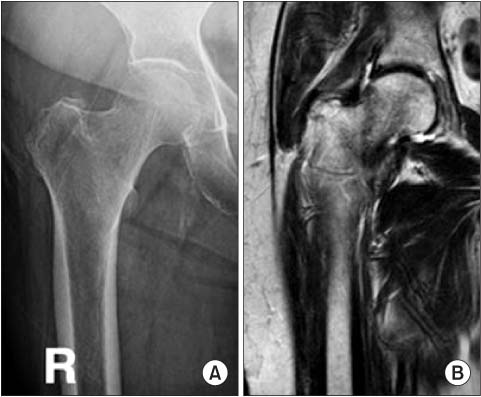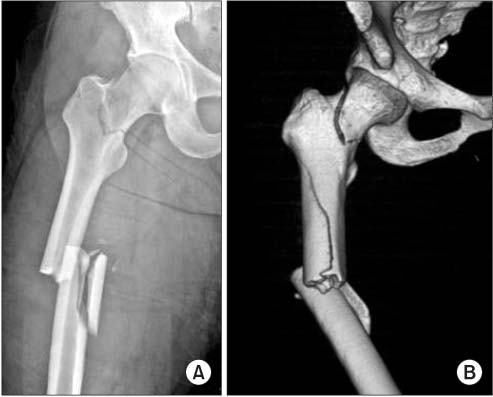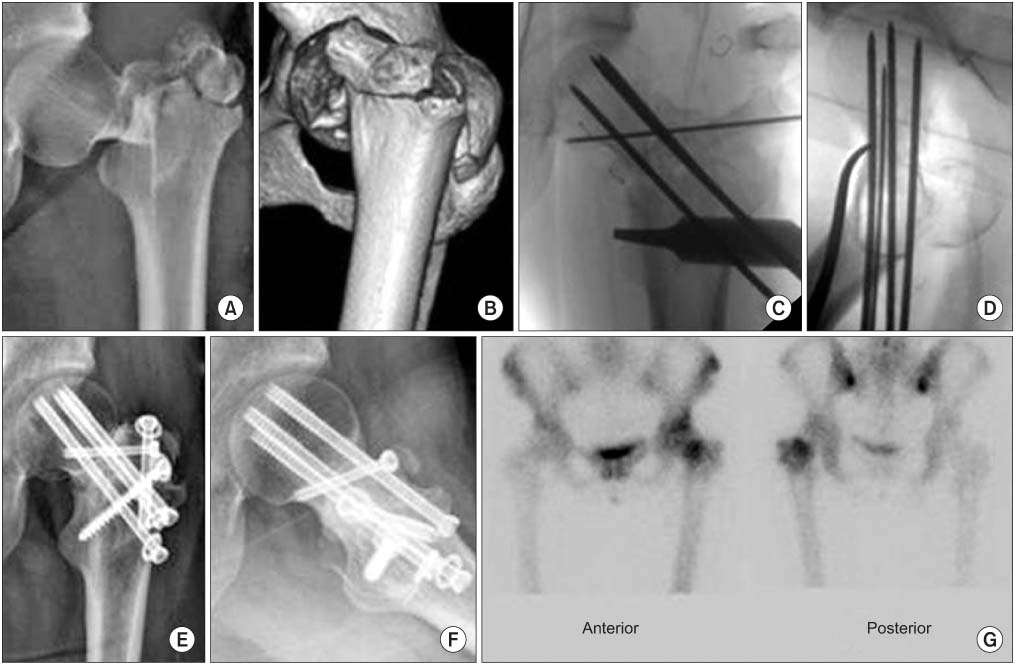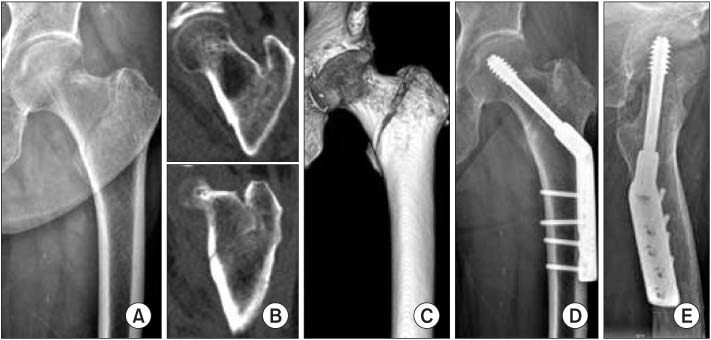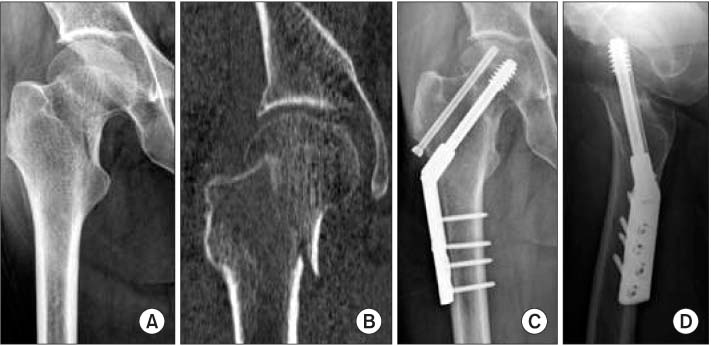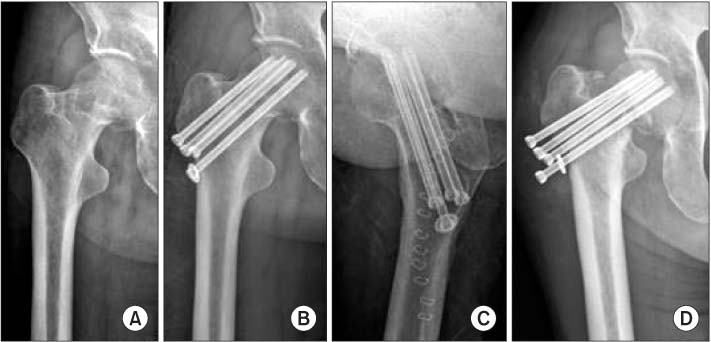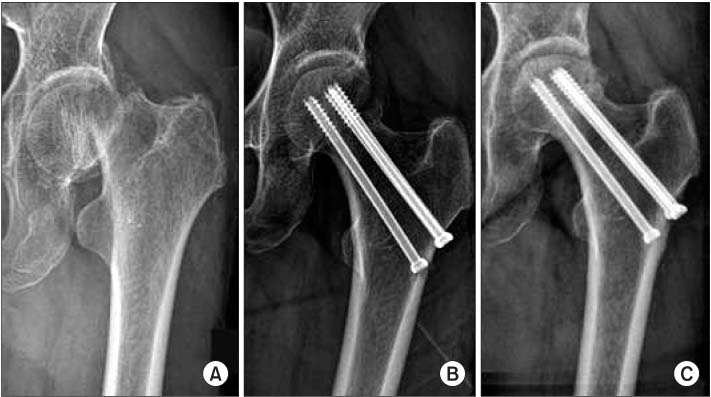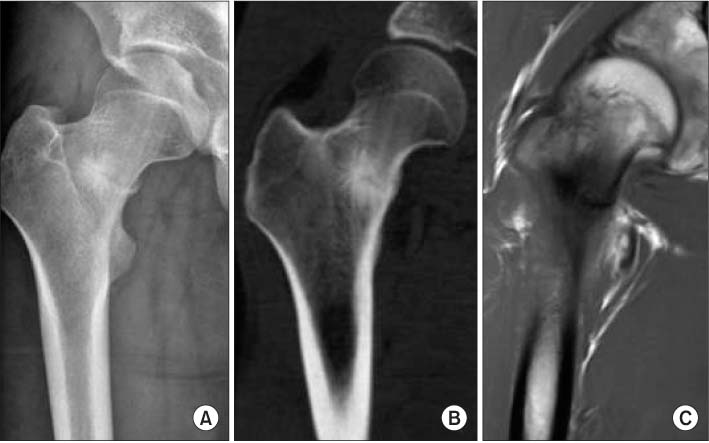J Korean Orthop Assoc.
2015 Jun;50(3):178-191. 10.4055/jkoa.2015.50.3.178.
Current Treatment Strategy for Young Adult Femur Neck Fractures
- Affiliations
-
- 1Department of Orthopedic Surgery, Samsung Medical Center, Sungkyunkwan University School of Medicine, Seoul, Korea. limsj70@gmail.com
- KMID: 1851952
- DOI: http://doi.org/10.4055/jkoa.2015.50.3.178
Abstract
- Femoral neck fracture in young adults represents a relatively uncommon, high-energy injury associated with higher incidence of complications including nonunion, avascular necrosis of the femoral head, and significant shortening. Preservation of the natural hip anatomy and mechanics is a priority in their management and anatomic reduction and stable internal fixation are critical to achieving the goals of treatment in this young patient population. Current evidence is insufficient to recommend an ideal management method; however, in this article we present the rationale and evidence for timing of surgery, role of capsulotomy, open versus closed reduction, and available internal fixation options.
Keyword
Figure
Reference
-
1. Fractures of the neck of femur. The Korean Fracture Society. Principles of fracture management. 1st ed. Seoul: Beommun;2013. p. 593–612.2. Christodoulou NA, Dretakis EK. Significance of muscular disturbances in the localization of fractures of the proximal femur. Clin Orthop Relat Res. 1984; 187:215–217.
Article3. Robinson CM, Court-Brown CM, McQueen MM, Christie J. Hip fractures in adults younger than 50 years of age. Epidemiology and results. Clin Orthop Relat Res. 1995; 312:238–246.4. Swiontkowski MF, Winquist RA, Hansen ST Jr. Fractures of the femoral neck in patients between the ages of twelve and forty-nine years. J Bone Joint Surg Am. 1984; 66:837–846.
Article5. Bartonícek J. Pauwels' classification of femoral neck fractures: correct interpretation of the original. J Orthop Trauma. 2001; 15:358–360.6. Baitner AC, Maurer SG, Hickey DG, et al. Vertical shear fractures of the femoral neck. A biomechanical study. Clin Orthop Relat Res. 1999; 367:300–305.
Article7. Bonnaire FA, Weber AT. Analysis of fracture gap changes, dynamic and static stability of different osteosynthetic procedures in the femoral neck. Injury. 2002; 33:Suppl 3. C24–C32.
Article8. Zlowodzki M, Ayieni O, Petrisor BA, Bhandari M. Femoral neck shortening after fracture fixation with multiple cancellous screws: incidence and effect on function. J Trauma. 2008; 64:163–169.
Article9. Strömqvist B. Femoral head vitality after intracapsular hip fracture. 490 cases studied by intravital tetracycline labeling and Tc-MDP radionuclide imaging. Acta Orthop Scand Suppl. 1983; 200:1–71.10. Trueta J, Harrison MH. The normal vascular anatomy of the femoral head in adult man. J Bone Joint Surg Br. 1953; 35:442–461.
Article11. Senn N, Peltier LF. The treatment of fractures of the neck of the femur by immediate reduction and permanent fixation. Clin Orthop Relat Res. 1987; 218:4–11.
Article12. Wolinsky PR, Johnson KD. Ipsilateral femoral neck and shaft fractures. Clin Orthop Relat Res. 1995; 318:81–90.13. Lubovsky O, Liebergall M, Mattan Y, Weil Y, Mosheiff R. Early diagnosis of occult hip fractures MRI versus CT scan. Injury. 2005; 36:788–792.14. Tornetta P 3rd, Kain MS, Creevy WR. Diagnosis of femoral neck fractures in patients with a femoral shaft fracture. Improvement with a standard protocol. J Bone Joint Surg Am. 2007; 89:39–43.15. Benterud JG, Husby T, Nordsletten L, Alho A. Fixation of displaced femoral neck fractures with a sliding screw plate and a cancellous screw or two Olmed screws. A prospective, randomized study of 225 elderly patients with a 3-year follow-up. Ann Chir Gynaecol. 1997; 86:338–342.16. Broos PL, Vercruysse R, Fourneau I, Driesen R, Stappaerts KH. Unstable femoral neck fractures in young adults: treatment with the AO 130-degree blade plate. J Orthop Trauma. 1998; 12:235–239. discussion 240
Article17. Stankewich CJ, Chapman J, Muthusamy R, et al. Relationship of mechanical factors to the strength of proximal femur fractures fixed with cancellous screws. J Orthop Trauma. 1996; 10:248–257.
Article18. Macaulay W, Yoon RS, Parsley B, Nellans KW, Teeny SM. DFACTO Consortium. Displaced femoral neck fractures: is there a standard of care? Orthopedics. 2007; 30:748–749.
Article19. Bhandari M, Devereaux PJ, Tornetta P 3rd, et al. Operative management of displaced femoral neck fractures in elderly patients. An international survey. J Bone Joint Surg Am. 2005; 87:2122–2130.20. Chua D, Jaglal SB, Schatzker J. Predictors of early failure of fixation in the treatment of displaced subcapital hip fractures. J Orthop Trauma. 1998; 12:230–234.
Article21. Garden RS. Reduction and fixation of subcapital fractures of the femur. Orthop Clin North Am. 1974; 5:683–712.
Article22. Moore AT. Hip joint fracture (a mechanical problem). Instr Course Lect. 1953; 10:35–49.23. Jain R, Koo M, Kreder HJ, Schemitsch EH, Davey JR, Mahomed NN. Comparison of early and delayed fixation of subcapital hip fractures in patients sixty years of age or less. J Bone Joint Surg Am. 2002; 84:1605–1612.
Article24. Karaeminogullari O, Demirors H, Atabek M, Tuncay C, Tandogan R, Ozalay M. Avascular necrosis and nonunion after osteosynthesis of femoral neck fractures: effect of fracture displacement and time to surgery. Adv Ther. 2004; 21:335–342.
Article25. Manninger J, Bagi I, Flóris I, et al. Biomechanical aspects of cannulated screw fixation. In : Manninger J, Bosch U, Cserháti P, Fekete K, Kazár G, editors. Internal fixation of femoral neck fractures: an Atlas. Wien; New York: Springer;2007. p. 113–114.26. Razik F, Alexopoulos AS, El-Osta B, et al. Time to internal fixation of femoral neck fractures in patients under sixty years: does this matter in the development of osteonecrosis of femoral head? Int Orthop. 2012; 36:2127–2132.27. Papakostidis C, Panagiotopoulos A, Piccioli A, Giannoudis PV. Timing of internal fixation of femoral neck fractures. A systematic review and meta-analysis of the final outcome. Injury. 2015; 46:459–466.
Article28. Beck M, Siebenrock KA, Affolter B, Nötzli H, Parvizi J, Ganz R. Increased intraarticular pressure reduces blood flow to the femoral head. Clin Orthop Relat Res. 2004; 424:149–152.
Article29. Strömqvist B, Nilsson LT, Egund N, Thorngren KG, Wingstrand H. Intracapsular pressures in undisplaced fractures of the femoral neck. J Bone Joint Surg Br. 1988; 70:192–194.30. Harper WM, Barnes MR, Gregg PJ. Femoral head blood flow in femoral neck fractures. An analysis using intra-osseous pressure measurement. J Bone Joint Surg Br. 1991; 73:73–75.
Article31. Maruenda JI, Barrios C, Gomar-Sancho F. Intracapsular hip pressure after femoral neck fracture. Clin Orthop Relat Res. 1997; 340:172–180.
Article32. Upadhyay A, Jain P, Mishra P, Maini L, Gautum VK, Dhaon BK. Delayed internal fixation of fractures of the neck of the femur in young adults. A prospective, randomised study comparing closed and open reduction. J Bone Joint Surg Br. 2004; 86:1035–1040.33. Christal AA, Taitsman LA, Dunbar RP Jr, Krieg JC, Nork SE. Fluoroscopically guided hip capsulotomy: effective or not? A cadaveric study. J Orthop Trauma. 2011; 25:214–217.
Article34. Petrie J, Sassoon A, Haidukewych GJ. When femoral fracture fixation fails: salvage options. Bone Joint J. 2013; 95:11 Suppl A. 7–10.35. Bosch U, Schreiber T, Krettek C. Reduction and fixation of displaced intracapsular fractures of the proximal femur. Clin Orthop Relat Res. 2002; 399:59–71.
Article36. Damany DS, Parker MJ, Chojnowski A. Complications after intracapsular hip fractures in young adults. A meta-analysis of 18 published studies involving 564 fractures. Injury. 2005; 36:131–141.37. Kregor PJ. The effect of femoral neck fractures on femoral head blood flow. Orthopedics. 1996; 19:1031–1036.
Article38. Ghayoumi P, Kandemir U, Morshed S. Evidence based update: open versus closed reduction. Injury. 2015; 46:467–473.
Article39. Song KS. Displaced fracture of the femoral neck in children: open versus closed reduction. J Bone Joint Surg Br. 2010; 92:1148–1151.40. Molnar RB, Routt ML Jr. Open reduction of intracapsular hip fractures using a modified Smith-Petersen surgical exposure. J Orthop Trauma. 2007; 21:490–494.
Article41. Watson-Jones R. Fractures of the neck of the femur. Br J Surg. 1936; 23:787–808.
Article42. Panteli M, Rodham P, Giannoudis PV. Biomechanical rationale for implant choices in femoral neck fracture fixation in the non-elderly. Injury. 2015; 46:445–452.
Article43. Chen Z, Wang G, Lin J, et al. Efficacy comparison between dynamic hip screw combined with anti-rotation screw and cannulated screw in treating femoral neck fractures. Zhongguo Xiu Fu Chong Jian Wai Ke Za Zhi. 2011; 25:26–29.44. Szita J, Cserháti P, Bosch U, Manninger J, Bodzay T, Fekete K. Intracapsular femoral neck fractures: the importance of early reduction and stable osteosynthesis. Injury. 2002; 33:Suppl 3. C41–C46.
Article45. Oakey JW, Stover MD, Summers HD, Sartori M, Havey RM, Patwardhan AG. Does screw configuration affect subtrochanteric fracture after femoral neck fixation? Clin Orthop Relat Res. 2006; 443:302–306.
Article46. Bjørgul K, Reikerøs O. Outcome of undisplaced and moderately displaced femoral neck fractures. Acta Orthop. 2007; 78:498–504.
Article47. Yang JJ, Lin LC, Chao KH, et al. Risk factors for nonunion in patients with intracapsular femoral neck fractures treated with three cannulated screws placed in either a triangle or an inverted triangle configuration. J Bone Joint Surg Am. 2013; 95:61–69.
Article48. Lindequist S. Cortical screw support in femoral neck fractures. A radiographic analysis of 87 fractures with a new mensuration technique. Acta Orthop Scand. 1993; 64:289–293.
Article49. Ly TV, Swiontkowski MF. Treatment of femoral neck fractures in young adults. Instr Course Lect. 2009; 58:69–81.50. Scheck M. Intracapsular fractures of the femoral neck. Comminution of the posterior neck cortex as a cause of unstable fixation. J Bone Joint Surg Am. 1959; 41:1187–1200.51. Holmes CA, Edwards WT, Myers ER, Lewallen DG, White AA 3rd, Hayes WC. Biomechanics of pin and screw fixation of femoral neck fractures. J Orthop Trauma. 1993; 7:242–247.
Article52. Sirkin M, Grossman MG, Renard RL, et al. A biomechanical analysis of fixation constructs in high angle femoral neck fracture. J Orthop Trauma. 2008; 14:131.53. Blair B, Koval KJ, Kummer F, Zuckerman JD. Basicervical fractures of the proximal femur. A biomechanical study of 3 internal fixation techniques. Clin Orthop Relat Res. 1994; 306:256–263.54. Swiontkowski MF. Intracapsular fractures of the hip. J Bone Joint Surg Am. 1994; 76:129–138.
Article55. Rupprecht M, Grossterlinden L, Ruecker AH, et al. A comparative biomechanical analysis of fixation devices for unstable femoral neck fractures: the Intertan versus cannulated screws or a dynamic hip screw. J Trauma. 2011; 71:625–634.
Article56. Röderer G, Moll S, Gebhard F, Claes L, Krischak G. Side plate fixation vs. intramedullary nailing in an unstable medial femoral neck fracture model: A comparative biomechanical study. Clin Biomech (Bristol, Avon). 2011; 26:141–146.
Article57. Aminian A, Gao F, Fedoriw WW, Zhang LQ, Kalainov DM, Merk BR. Vertically oriented femoral neck fractures: mechanical analysis of four fixation techniques. J Orthop Trauma. 2007; 21:544–548.
Article58. Boraiah S, Paul O, Hammoud S, Gardner MJ, Helfet DL, Lorich DG. Predictable healing of femoral neck fractures treated with intraoperative compression and length-stable implants. J Trauma. 2010; 69:142–147.
Article59. Della Rocca GJ. Gaps and opportunities in the management of the young femoral neck fracture. Injury. 2015; 46:515–518.
Article60. Talboys R, Pickup L, Chojnowski A. The management of intracapsular hip fractures in the 'young elderly' internal fixation or total hip replacement? Acta Orthop Belg. 2012; 78:41–48.61. Miller BJ, Callaghan JJ, Cram P, Karam M, Marsh JL, Noiseux NO. Changing trends in the treatment of femoral neck fractures: a review of the american board of orthopaedic surgery database. J Bone Joint Surg Am. 2014; 96:e149.62. Jackson M, Learmonth ID. The treatment of nonunion after intracapsular fracture of the proximal femur. Clin Orthop Relat Res. 2002; 399:119–128.
Article63. Angelini M, McKee MD, Waddell JP, Haidukewych G, Schemitsch EH. Salvage of failed hip fracture fixation. J Orthop Trauma. 2009; 23:471–478.
Article64. Rawall S, Bali K, Upendra B, Garg B, Yadav CS, Jayaswal A. Displaced femoral neck fractures in the young: significance of posterior comminution and raised intracapsular pressure. Arch Orthop Trauma Surg. 2012; 132:73–79.
Article65. Kuo LT, Lin SJ, Hsu WH, Peng KT, Lin CL, Hsu RW. The effect of renal function on surgical outcomes of intracapsular hip fractures with osteosynthesis. Arch Orthop Trauma Surg. 2014; 134:39–45.
Article66. Duckworth AD, Bennet SJ, Aderinto J, Keating JF. Fixation of intracapsular fractures of the femoral neck in young patients: risk factors for failure. J Bone Joint Surg Br. 2011; 93:811–816.67. Brinker MR, O'Connor DP, Monla YT, Earthman TP. Metabolic and endocrine abnormalities in patients with nonunions. J Orthop Trauma. 2007; 21:557–570.
Article68. Johnson AL, Smith JJ, Smith JM, Sanzone AG. Vitamin D insufficiency in patients with acute hip fractures of all ages and both sexes in a sunny climate. J Orthop Trauma. 2013; 27:e275–e280.
Article69. Schweitzer D, Melero P, Zylberberg A, Salabarrieta J, Urrutia J. Factors associated with avascular necrosis of the femoral head and nonunion in patients younger than 65 years with displaced femoral neck fractures treated with reduction and internal fixation. Eur J Orthop Surg Traumatol. 2013; 23:61–65.70. Liu B, Cao Y, Wang D, Yao G, Bi Z. Vascular endothelial growth factor -634G/C polymorphism associated with osteonecrosis of the femoral head in a Chinese population. Genet Test Mol Biomarkers. 2012; 16:739–743.
Article71. Bachiller FG, Caballer AP, Portal LF. Avascular necrosis of the femoral head after femoral neck fracture. Clin Orthop Relat Res. 2002; 399:87–109.
Article72. Watanabe Y, Terashima Y, Takenaka N, Kobayashi M, Matsushita T. Prediction of avascular necrosis of the femoral head by measuring intramedullary oxygen tension after femoral neck fracture. J Orthop Trauma. 2007; 21:456–461.
Article73. Sharma S, Fraser M, Lovell F, Reece A, McLellan AR. Characteristics of males over 50 years who present with a fracture: epidemiology and underlying risk factors. J Bone Joint Surg Br. 2008; 90:72–77.74. Tucker KL, Jugdaohsingh R, Powell JJ, et al. Effects of beer, wine, and liquor intakes on bone mineral density in older men and women. Am J Clin Nutr. 2009; 89:1188–1196.
Article75. Egol KA, Koval KJ, Kummer F, Frankel VH. Stress fractures of the femoral neck. Clin Orthop Relat Res. 1998; 348:72–78.
Article
- Full Text Links
- Actions
-
Cited
- CITED
-
- Close
- Share
- Similar articles
-
- Bilateral Femoral Neck Fractures in a Young Adult: A Case Report
- Femoral neck fractures in young adults
- Bipolar hemiarthroplasty as secondary procedure for femoral neck fractures in young adults
- Femur Neck Fracture in a Young Marfan Syndrome Patient
- Bilateral Stress Fracture of Femur Neck, Fatigue Type of Non-Athlete Young Adult

